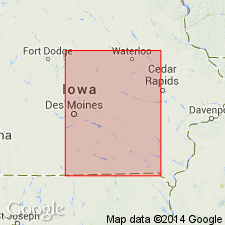
- Usage in publication:
-
- Swede Hollow Formation
- Modifications:
-
- Named
- Dominant lithology:
-
- Coal
- Shale
- Mudstone
- Limestone
- AAPG geologic province:
-
- Iowa shelf
Summary:
Named for exposures (the type locality) along a tributary to Whitebreast Creek in Swede Hollow in secs 33 and 34, T73N, R22W, and sec 3, T72N, R22W, Lucas Co, IA on the Iowa shelf as the upper formation (of 4) of the Cherokee Group of the Des Moines Supergroup. Overlies Floris Formation (new) of Cherokee Group. Underlies Mouse Creek Formation (new) of Marmaton Group. Is a marine-nonmarine cyclothemic unit. Averages 100 ft thick. Divided into (ascending): Whitebreast Coal Member (new), Oakley Shale Member (new), Ardmore Limestone Member (a MO name extended into IA), unnamed mudstone, Wheeler Coal Member (a MO name extended into IA), unnamed shale, Bevier Coal Member (a MO name extended into IA), an unnamed shale and limestone sequence, and Mulky Coal Member (a MO name extended into IA). Nomenclature chart. Cross section. Graphic section. The coal beds are thin (1.4-1.9 ft thick) and persistent. The shales are brown, gray to black; some beds are silty; some have phosphate nodules. The mudstones are gray to brown, silty. The limestones are gray, nodular fossiliferous. Is 106+ ft thick at type. Contains sediments (of Whitebreast, Oakley, Ardmore) deposited during major episode of marine transgression and regression, and sediments related to deltaic progradation and abandonment. Of Desmoinesian, Pennsylvanian age.
Source: GNU records (USGS DDS-6; Denver GNULEX).
For more information, please contact Nancy Stamm, Geologic Names Committee Secretary.
Asterisk (*) indicates published by U.S. Geological Survey authors.
"No current usage" (†) implies that a name has been abandoned or has fallen into disuse. Former usage and, if known, replacement name given in parentheses ( ).
Slash (/) indicates name conflicts with nomenclatural guidelines (CSN, 1933; ACSN, 1961, 1970; NACSN, 1983, 2005, 2021). May be explained within brackets ([ ]).

